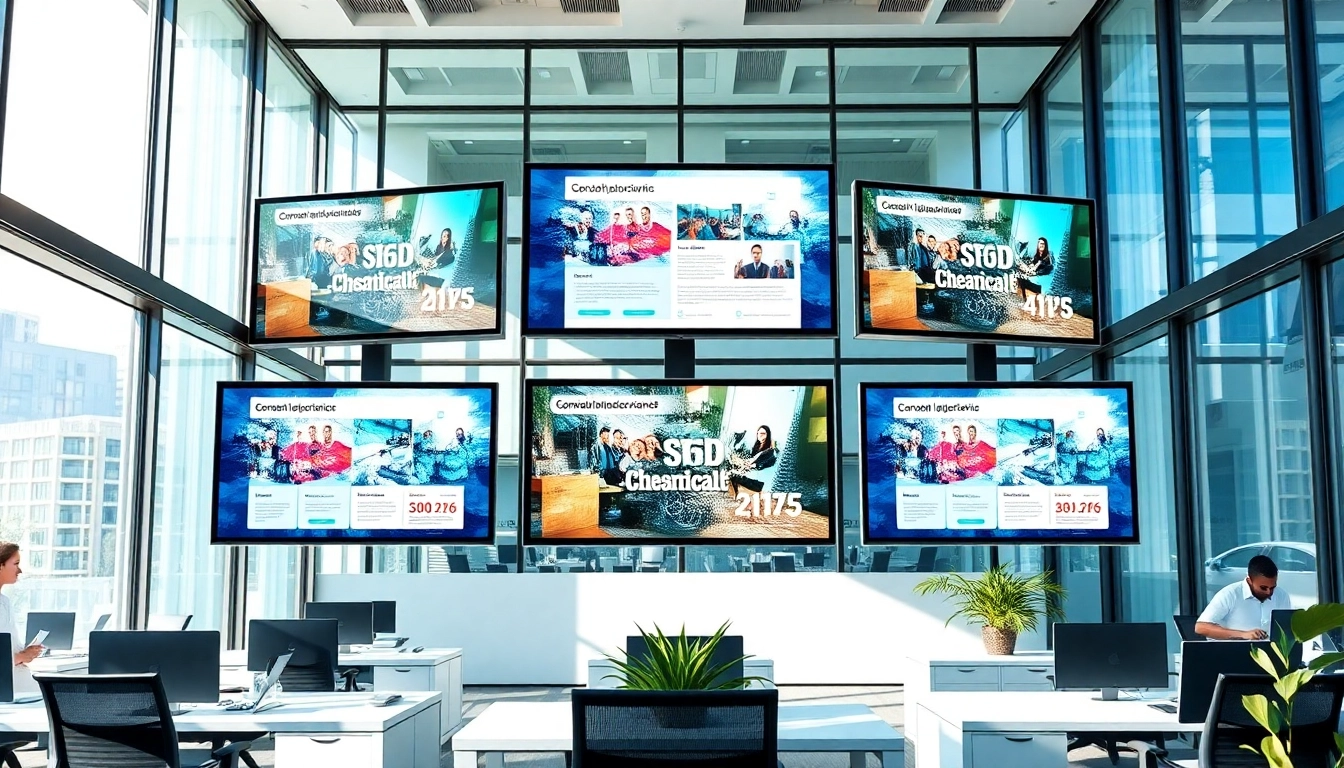Understanding the Importance of Digital Signage for Offices
In today’s fast-paced business world, effective communication is more critical than ever. Enterprises are increasingly turning to Digital signage for offices to streamline their communication, enhance employee engagement, and foster a more integrated corporate culture. Digital signage serves as a dynamic platform that can convey messages in real time, providing an array of benefits tailored to the unique needs of office spaces.
What is Digital Signage for Offices?
Digital signage for offices refers to the use of digital displays to showcase information, announcements, or interactive content in office environments. This technology encompasses a wide range of formats, including digital boards, video walls, and interactive kiosks. Positioned strategically throughout the workplace, digital signage serves as a conduit for information sharing, ranging from corporate communications and event updates to employee recognition and safety protocols.
Benefits of Implementing Digital Signage for Offices
Implementing digital signage in office settings offers several advantages, including:
- Enhanced Communication: Digital signage enables real-time updates which can significantly improve internal communications. Important messages can be displayed instantly, ensuring that all employees are informed and aligned.
- Increased Engagement: By incorporating vibrant visuals and interactive content, digital signage can captivate employees’ attention, promoting engagement and participation in corporate initiatives.
- Streamlined Information Sharing: Digital signage allows for centralized content management, making it easier to share relevant information across various departments or teams.
- Aesthetic Appeal: Well-designed digital displays enhance office aesthetics, transforming bland spaces into vibrant environments that reflect corporate branding.
- Cost-Efficiency: While the initial investment may seem substantial, the long-term savings on printed materials and the ability to make updates quickly can make digital signage a cost-effective solution.
Common Challenges with Digital Signage for Offices
Despite the many benefits, businesses may face challenges when implementing digital signage:
- Integration with Existing Systems: Ensuring that digital signage systems integrate seamlessly with existing communication and content management systems can be complex and requires careful planning.
- Content Management: Frequent updates necessitate robust content management strategies. Without ongoing content curation, digital signage can quickly become stale and ineffective.
- Technical Issues: Like any technological solution, digital signage may encounter malfunctions or connectivity issues, which can disrupt communication flow if not managed promptly.
Best Practices for Implementing Digital Signage for Offices
Choosing the Right Displays for Digital Signage for Offices
Selecting appropriate display hardware is critical for the success of digital signage in office environments. Decisions should consider factors such as size, location, brightness, and resolution. For example, larger, high-resolution displays are ideal for reception areas where visual impact is essential, while smaller screens may suffice for break rooms or corridors. Additionally, consider the environment — outdoor screens, for instance, need to be weatherproof and bright enough to be viewed in sunlight.
Content Creation Strategies for Digital Signage for Offices
To maximize the effectiveness of digital signage, content must be engaging, relevant, and easily digestible. Strategies include:
- Visual Storytelling: Utilize graphics, animations, and videos to complement text. Visual content is often more engaging and easier to recall.
- Regular Updates: Establish a consistent schedule for content refreshes to keep messages timely and relevant.
- Audience Segmentation: Cater content to specific teams or departments, ensuring the information resonates with its intended audience.
Installation and Maintenance Tips for Digital Signage for Offices
Proper installation and maintenance are key to the long-term performance of digital signage systems. Here are some essential tips:
- Professional Installation: Hiring professionals for installation can ensure optimal placement, wiring, and connectivity, minimizing technical issues.
- Routine Maintenance: Schedule regular maintenance checks to troubleshoot any potential issues before they impact functionality.
- Software Updates: Keep the digital signage software updated to benefit from new features and security enhancements.
Case Studies: Successful Digital Signage for Offices
Innovative Uses of Digital Signage for Offices
Various organizations have leveraged digital signage effectively to enhance their operations. For instance, one multinational company used digital signage to create a dynamic and engaging environment in their offices, showcasing employee achievements, real-time metrics related to sustainability goals, and essential HR communications. This kind of implementation not only informed employees but also fostered a sense of community and motivation.
Employee Engagement through Digital Signage for Offices
Another organization used their digital signage to enhance employee engagement through interactive displays. By introducing a platform that allowed employees to contribute to content—like sharing personal milestones or team successes—they transformed passive screens into active communication tools that encouraged participation.
Revenue Growth with Effective Digital Signage for Offices
Companies that integrated digital signage into their sales processes reported notable revenue growth. For example, by utilizing screens to display analytics data, sales teams were empowered to make informed decisions quickly. The visibility of metrics and performance indicators led to heightened awareness and accountability, translating to increased sales performance.
Evaluating the Effectiveness of Digital Signage for Offices
Key Performance Indicators for Digital Signage for Offices
To determine the effectiveness of digital signage, organizations should track relevant key performance indicators (KPIs), including:
- Engagement Metrics: Analyze how frequently and for how long employees interact with digital signage. Tracking engagement can provide insights into content effectiveness.
- Feedback and Surveys: Regularly solicit feedback from employees on the relevance and clarity of the information displayed.
- Digital Signage Usage Data: Monitor usage patterns to determine how often different screens are viewed and the types of content that generate the most interest.
Feedback Collection from Staff on Digital Signage for Offices
Collecting feedback is vital to refining the digital signage strategy. Conduct surveys to understand employee opinions on displayed content and how it impacts their work experience. Utilizing focus groups can also reveal valuable qualitative insights that data alone may not provide.
Adapting Strategies Based on Analytics from Digital Signage for Offices
Organizations should use analytics to adapt digital signage strategies over time. For instance, if data indicates that certain messages resonate more with employees, organizations can prioritize that content type. Additionally, understanding when employees are most likely to engage with signage can inform timing for displaying important announcements.
The Future of Digital Signage for Offices
Emerging Trends in Digital Signage for Offices
The digital signage landscape is rapidly evolving, driven by technological advancements and changing workplace dynamics. Organizations are increasingly gravitating towards personalized content tailored to individual employee preferences, creating more meaningful interactions with the signage. Sustainability is also becoming a focus, with more companies opting for energy-efficient displays and eco-friendly content that aligns with corporate responsibility goals.
Technological Advancements Impacting Digital Signage for Offices
Innovations in artificial intelligence (AI) and machine learning are set to revolutionize digital signage. These technologies can analyze viewer behavior and adapt content in real-time, ensuring messages remain relevant and engaging. Furthermore, integration with mobile devices can enhance interactivity, allowing employees to customize their engagements with digital displays through personal devices.
Integrating Interactive Elements into Digital Signage for Offices
Future trends indicate a move towards incorporating interactive elements into digital signage solutions. Touch-enabled displays, QR codes, and gamified content can engage employees more deeply and create unique experiences that enhance learning and participation. By fostering an interactive environment, businesses can cultivate a workplace atmosphere that stimulates collaboration and innovation.



